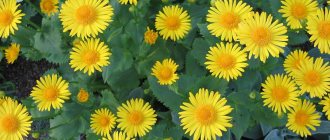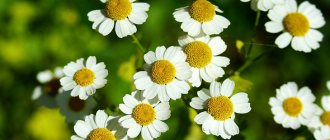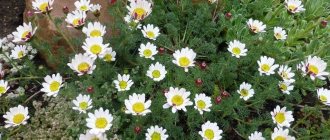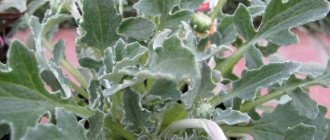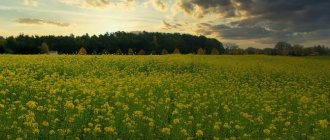Author: Natalya Category: Garden plants Published: February 27, 2019 Updated: December 13, 2019
plant (lat. Matricaria) is a genus of herbaceous flowering perennials of the Compositae, or Asteraceae, family, uniting approximately twenty species of low aromatic herbs that bloom in the first year. In nature, daisies grow in Eurasia, both Americas, South Africa and Australia. It is curious that daisies also grew in Central Africa, but were destroyed by local tribes because they allegedly attracted evil spirits.
The most famous species of the genus is chamomile, which has long been widely used for cosmetic and medicinal purposes. The Latin name of the genus is derived from the word translated as “uterus” - this is explained by the fact that chamomile was used in the treatment of gynecological diseases. Pliny the Elder described chamomile in his multi-volume Natural History under the name Chamaemellon, formed from two words meaning “low” (apparently, the short stature of chamomile was meant) and “apple” (the smell of chamomile was reminiscent of the aroma of apples). The Russian name of the plant comes from the Polish language and is derived from the word romana, which means “Roman”.
Chamomile is often confused with plants of the Asteraceae family such as gerbera, aster, pyrethrum, chrysanthemum and cornflower, which is called garden chamomile. Actually, our story will be about garden chamomile, that is, about daisy, especially since planting and caring for daisies is no different from growing daisy, which for convenience we will call chamomile in the article.
Planting and caring for chamomile
- Planting: sowing seeds in the ground - at the end of May, sowing seeds for seedlings - in March, planting seedlings in the garden - in May.
- Flowering: from early July to September.
- Lighting: bright sunlight.
- Soil: slightly alkaline or neutral, in an area with deep groundwater.
- Watering: During the rooting period, seedlings are watered frequently, but then watering is required only during periods of prolonged drought.
- Top dressing: humus, peat and compost are added to the soil annually, and in mid-spring ammonium nitrate is scattered over the area at the rate of 20 g of fertilizer per m². There is no need to water the area after this.
- Reproduction: by seeds and dividing the bush.
- Pests: aphids, thrips, star flies and wireworms.
- Diseases: affected by powdery mildew, gray mold, rust and fusarium.
Read more about growing chamomile below.
Description and photo of field chamomile
Field chamomile is a perennial plant that is used for medicinal purposes, in landscape design, and for creating bouquets. Flowers and leaves are used in cosmetics to make masks, natural creams, and safe hair dyes. As an ornamental plant, chamomile is used for arranging flower beds, borders, rockeries, and creating flower arrangements.
In Russia, the plant is found along roads, in wastelands, and meadows. When growing on the site, it is necessary to prepare alkaline soil and ensure drainage. Seeds are sown in spring in an area with good lighting.
The flower belongs to the honey plant. The flowering period is from June to September. The culture is frost-resistant. The root system of the plant is taprooted, the inflorescences have the shape of baskets.
The plant contains the following beneficial substances:
- tanning components;
- glucose;
- multivitamins;
- essential oil extracts;
- vitamins C, K, E, group B;
- flavonoids;
- fatty acid;
- protein compounds;
- azulene;
- salicylic acid, etc.
Field chamomile (flowers and leaves) are used for medicinal purposes in the form of infusions, teas, decoctions, and compresses. Essential oils are used in aromatherapy. Decoctions and teas have the following effects on the body:
- anti-inflammatory;
- painkiller;
- diuretic;
- sedative;
- vasodilator;
- antiallergic;
- anti-cold;
- antitussive;
- choleretic, etc.
When using a plant extract, the following therapeutic effect occurs:
- appetite is normalized, food absorption is improved;
- immunity improves;
- skin disinfection;
- regulation of the activity of the kidneys, liver and gastrointestinal tract;
- elimination of spasms;
- normalization of emotional state, improvement of sleep quality;
- stimulating hair growth, strengthening hair follicles;
- cleansing the dermis, making the skin smooth, etc.
Use of chamomile in folk medicine:
- Colds are treated with tea made from flowers; the drink has an antipyretic effect, a diaphoretic effect, and the concentration of essential components helps in the fight against viral infections. For sore throats, chamomile infusions are used to relieve pain and relieve inflammation.
- The use of decoctions for diseases of the stomach and intestines, chamomile has a softening and enveloping effect on the mucous membrane of the digestive organs. Decoctions help neutralize toxins, eliminate inflammation, relieve irritation, and reduce acidity levels.
- In combination with medications, decoctions are used to treat gastritis, stomach ulcers, and colitis.
- Tea with chamomile, supplemented with honey, helps eliminate sleep disturbances and stabilize the nervous system.
- The drink is useful for restoring hormonal levels and treating female organs.
Use of the plant in cosmetology:
- masks with the addition of chamomile extract improve the condition of the dermis, trigger rejuvenation and regeneration processes, and have a cleansing effect;
- protection of the dermis from photoaging is carried out using natural creams with chamomile;
- reducing exposure to the external environment, removing toxic substances when using chamomile-based lotion;
- compresses help eliminate skin diseases, allergic reactions, itching;
- creams with the addition of plant extract help improve complexion, even out the structure of the dermis, start regeneration processes, and eliminate fine wrinkles;
- a flower decoction helps to steam the dermis before cleansing, after washing it helps eliminate redness and disinfect the skin;
- plant extract is included in the composition of hygienic lipstick, which has a protective, moisturizing effect on the skin of the lips;
- essential oil extract is used in anti-cellulite lotions and nourishing body creams;
- decoctions are used in rinsing hair, giving shine and rich tone to curls, and strengthening hair follicles.
We recommend that you read the benefits of green beans
Contraindications for the use of plant extract:
- The plant is not used in decoctions for pregnant women, because has a great impact on hormonal levels.
- During lactation, medications with chamomile are prescribed only after consultation with a doctor.
- Decoctions are not recommended for chronic diseases. The rules for combining chamomile and medicines are determined by the doctor.
- Exceeding the recommended dose of chamomile extract may cause headaches, nausea, and increased blood pressure.
- The herbal component is not used if you have an individual intolerance to chamomile, because Swelling, redness of the skin, etc. may occur.
Chamomile flowers - description
Garden chamomile, or cornflower, or popovnik (lat. Leucanthemum vulgare), is a herbaceous plant from 15 to 60 cm in height with a short root, erect, slightly faceted stem, spatulate, crenate basal leaves on long petioles and oblong, irregularly serrated along the edges stem leaves, two of which, located in the upper part of the stem, are greatly reduced in size compared to the rest.
Growing chamomile from seeds
Sowing chamomile
Growing chamomile is possible in seedlings and without seedlings. You can sow garden chamomile seeds simply in the ground, but it is safer to use the seedling method.
Chamomile seeds are sown for seedlings in March. Trays with cells are filled with a moist, light, breathable substrate consisting of peat and sand in equal parts, 2-3 seeds are placed in each cell, sprinkled with a thin layer of substrate on top, the container is covered with a transparent film and placed close to the window, but not on window sill, since the light passing through the glass is too intense and can damage the seed germination process. Monitor the condition of the soil, and as soon as it dries, moisten it with a spray bottle.
Chamomile seedlings
When the seedlings begin to appear, and at normal room temperature this will happen in one and a half to two weeks, remove the film and place the container as close to a sunny window as possible, protecting the seedlings from drafts. If this is not possible for any reason, place a fluorescent lamp over the container, which should work for at least 14 hours a day. As soon as the chamomile seedlings reach a height of 5 cm, leave only one, the most developed seedling, in each cell.
Do not pull out unnecessary seedlings, but carefully pinch them off above the soil surface, because you risk damaging the root system of the remaining seedling. In order for chamomile to bush, pinch it over 3-4 leaves.
Planting chamomile in open ground
When to plant daisies in the ground
Seedlings are planted in the ground at the age of 4-6 weeks, when all possible frosts have passed. Garden chamomile loves sunny areas with calcareous or neutral soil and deep groundwater.
How to plant daisies
Planting daisies in the ground is carried out after preparing the site - complex fertilizer for flowers must be added to the soil for digging. Dig holes 20-30 cm deep at a distance of 20 to 40 cm from each other - the distance between the bushes and the depth of the holes depend on the chamomile variety. Remove the seedlings from the cells along with the earthen ball, plant them in the holes, press the soil around the stems and water the seedlings. Chamomiles from seeds will bloom next year.
When and how to replant daisies
How and when to replant large daisies is recommended by experienced flower growers.
If it is spring, then it is impossible to clearly indicate the timing of planting seedlings in open ground, since everything depends on the weather. Seedlings need to not only be grown strong, but also protected from cold and frost. When the seedlings have grown sufficiently and 4-5 true leaves have blossomed, they can be planted in open ground provided that the air temperature is + 15 °C or more.
Before planting chamomile seedlings in open ground, the soil is well dug up and fertilized with special preparations for flowering garden plants. After which the bushes need to be planted in groups of 2-3, at a distance of 30-40 cm.
Very often a situation arises where you need to quickly decide where and when it is best to plant perennial adult daisies. This happens when a plant is forced to be transplanted from a flower bed near the house due to construction work or the flower bed is moved to another place. Thanks to the peculiarities of the culture, the way out of this situation is quite simple - this flower is unpretentious and hardy, painlessly takes root in another place. Carefully enough, so as not to damage the roots, dig up the flowering plant with a lump of earth and move it to a new place, then water it generously.
Caring for daisies in the garden
How to care for chamomile
Until the chamomile seedlings become comfortable in the soil and begin to grow, they need to be watered frequently, but after rooting, the flowers require watering only in dry weather. To keep moisture in the soil longer, mulch the surface around the plant with peat. Otherwise, caring for daisies consists of loosening the soil, weeding the area, fertilizing and preparing perennial plants for winter.
Humus, peat and compost are added to the soil annually as fertilizers. In mid-spring, ammonium nitrate is scattered between the rows at the rate of 20 g per m² without subsequent watering. During the budding period, it is advisable to apply a urea solution to plants with faded stems and leaves. Slaked lime or dolomite flour is added to acidic soil in the fall.
Chamomile propagation
Garden daisies are propagated by dividing the bush and by seed. Despite the fact that perennial daisies can grow in one place for five years, after 2-3 years the bushes become too dense, shoots die off in the middle of the bush, the size of the inflorescences decreases, and the plant loses its attractiveness. This can be avoided by promptly planting young, strong shoots from the bush. At the end of September or beginning of October, on a cloudy, cool day, separate a part from the bush and plant it in a prepared hole, spilled with settled water, and fill the resulting void with fertile soil.
Next time, dig up and replant part of the bush on the opposite side. This is how varietal and double daisies are propagated. If you want to achieve the largest flowers on powerful stems, you need to divide your daisy bushes annually.
Garden daisies also reproduce by seeds. We have described growing chamomile seedlings to you, but you can sow the seeds directly into the ground before winter. In cold soil they will undergo natural stratification and germinate together in the spring, and all you have to do is thin out the seedlings.
Pests and diseases of daisies
With insufficient or irregular care, chamomiles have a chance of developing powdery mildew, gray mold, rust and fusarium.
Powdery mildew appears as a whitish coating on the above-ground parts of the plant, which gradually turns brown.
Rust appears as dark red spots on the upper side of the leaves, and on the lower side it forms pads with fungal spores.
Fusarium is also a fungal disease, in which the roots and root collar of young plants begin to rot, the tissues become brown, the stem becomes thinner, and the leaves turn yellow.
Gray rot is manifested by rapidly increasing in size brown necrotic spots on shoots and leaves. At high air humidity, the spots are covered with gray mycelium fluff.
To prevent fungal infection of flowers, do not allow excess moisture in the soil, promptly remove weeds and loosen the soil. It is better to immediately remove a specimen infected with gray rot so that the disease does not spread to neighboring plants.
Yellow race
Yellow chamomile is often called doronicum. Doronicum blooms early - already in May its single, bright yellow flowers with a golden tint really resemble a chamomile, and its rounded leaves form a continuous carpet on the soil. Doronicum is undemanding to soil, but grows better in loose, fertile, fairly moist soils, in the sun, and shading in the hottest time of the day promotes longer flowering. The plant is cold-resistant and can grow in one place for many years. It reproduces vegetatively; it is best to divide the bushes in mid-summer every 2–3 years. Doronicum stands well as a cut flower, especially if you cut off half-opened flowers. The first to bloom in early May is the eastern doronicum, and a week later the plantain doronicum. Both bloom for more than a month. The garden form of Doronicum plantain has quite large flowers, up to 10 cm in diameter, and the plant height reaches 1 m. Doronicum eastern, or Caucasian, is lower, up to 50 cm in height, and has the terry variety Sprin Beauty. After flowering, the plant sharply loses its decorative effect, the leaves turn yellow and die, so it is better to plant it in the background.
Small petal (erigeron) is an old garden crop. Beautiful small petal and its hybrid varieties are common in our country. Grows well in fertile neutral soils in sunny places. During the growth period it needs good care, watering and fertilizing. Bushes up to 60 cm high. Blooms profusely from mid-July for a month, flowers up to 4 cm in diameter. Propagated by seeds and division of the bush. Seeds have low germination. The bushes are divided at least once every four years. Hilling with humus or compost will help preserve the decorative appearance for another two years, but flowering will weaken. Small petal varieties have lilac, pink, lilac or white petals, which can be simple, semi-double, or double. Cuttings stand very well in water, especially in varieties with white flowers.
Gaillardia spinosa has large, daisy-like flowers with bright red-orange petals with golden edges and brown or purple centers. This is a very beautiful perennial, 60–70 cm high, blooming from June until autumn. Flowers are from 5 to 10 cm in diameter. Cuttings stand well in water. There are low-growing and terry varieties. Gaillardia is unpretentious and cold-resistant, does not like excess moisture, blooms well in sunny areas with light, well-drained soils. During the budding period, it needs to be fed with complete mineral fertilizer (gaillardia does not tolerate feeding with manure). It is propagated by dividing bushes and seeds. Without dividing or replanting, it can grow in one place for up to four years; it must be divided in early spring before flowering. Seeds can be sown directly into the ground in the spring; the plant blooms in the second year.
Perennial daisies after flowering
How and when to collect daisy seeds
If you want to collect seeds, wait for several large flowers to dry, and only then cut them off, dry them in a dry room with good ventilation and remove the seeds from the middle tubular flowers onto paper. They will need to be winnowed, poured into a paper bag and stored in a dry, dark place. Nielberry seeds remain viable for 2-3 years. However, remember that when propagated by seed, varietal and double daisies do not inherit the characteristics of their parents.
Preparing daisies for winter
Planting and caring for perennial daisies is no different from growing annual daisies, except for one thing - they need to be covered for the winter. Before the onset of cold weather, the stems of perennial garden daisies are cut off at surface level, after which the area is covered with dry leaves, sawdust or covered with non-woven material.
Chamomile transplant
Garden chamomile can grow in one place for up to five years. But, usually, in the third year of growth, the bushes become too dense, and their inner part begins to die off. In order to preserve the spectacular and decorative appearance of the plant, it should be replanted at this moment. It is advisable to do this in the autumn, after flowering has ended. To replant, you need to choose a cloudy day, dig up a garden chamomile bush and separate well-developed young shoots from it and plant them in a prepared area.
Types and varieties of daisies
In addition to the common cornflower, or meadow chamomile, there are other types of cornflower that are grown in cultivation.
Meadow chamomile (Leucanthemum vulgare)
Or common cornflower, grows in Western Europe, Ukraine, the European part of Russia, and southern Siberia. This is a perennial up to 90 cm high with single inflorescences-baskets with a diameter of 6-7 cm with white reed flowers and yellow tubular ones. The species has been in cultivation since 1500. The best garden forms of the species are:
- Sans Souci is a cornflower up to 1 m high with inflorescences up to 12 cm in diameter. White reed flowers are arranged in 6-8 rows, the few middle flowers are yellow;
- May Queen is a traditional chamomile, very popular in amateur gardens, up to 50 cm high with bright, shiny dark green leaves forming the ground cover;
- Maxima Koenig is a plant up to 1 m high with inflorescences up to 12 cm in diameter with dark yellow middle flowers and two rows of white reed flowers.
Kuril cornflower (Leucanthemum kurilense)
A late-blooming rock daisy with dissected leaves, growing in the Kuril Islands and on the Japanese island of Hokkaido. The rhizome of this species is fleshy and thickened. The plant reaches only 20 cm in height, while its few single baskets have a diameter of 5 to 8 cm. The marginal flowers are white. The Kuril cornflower has a variety called arcticum, which differs in the shape of its leaves.
Swamp cornflower (Leucanthemum paludosum)
It is also known as the marsh chrysanthemum (Chrysanthemum paludosum) native to the south of Portugal and Spain. This is a low-growing, but very bushy plant up to 25 cm high with sessile spatulate alternate leaves of bright green color and crenate along the edge. Inflorescences are numerous baskets up to 3 cm in diameter with short reed flowers of white color and a large yellow center of tubular flowers.
Photos of bouquets of daisies
Bouquets of daisies (photo) are created using the following methods:
- Asymmetrical - several flowers of different sizes are selected, you can include other flowers and assemble the composition in a chaotic manner. The shades in the bouquet should be harmoniously combined.
- Parallel - the flowers are laid out in a ladder, the buds are arranged in steps. The stems are fastened with a special tape. At the end of the assembly process, decorative branches and accessories are included in the bouquet.
- Flowers can be laid out in a spiral, gradually changing the angle of inclination. The buds can be held together with green branches.
- Figurative arrangement of flowers allows you to create an original bouquet in the form of a hemisphere, fan, heart, triangle, etc. Images of installation schemes are contained in electronic sources and in collections of photographs of finished flower arrangements.
We recommend that you read Turmeric in the treatment of the stomach and intestines



